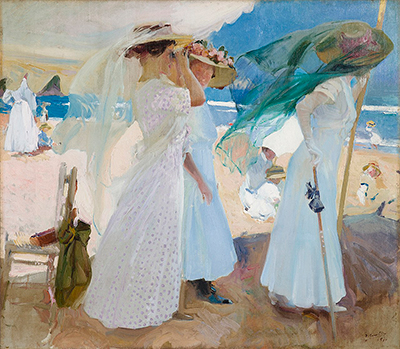Joaquin Sorolla y Bastida (1863 – 1923), painted Under the Awning, Zarauz, in 1910. From his earliest working days, Sorolla favoured painting groups of people, in particular family subjects in the tradition of Diego Velazquez (1599-1660).
This seventeenth-century artist painted Las Meninas, the famous portrait of the Spanish royal family. And like his predecessor, Sorolla liked to show his subjects in conversation and interacting in various ways. However, although the women in Sorolla's paining are his relatives, this painting is not a portrait. The viewer is unable to distinguish their features, which are either indistinct or hidden. Rather, the artist has grouped the subjects to capture the carefree mood of a day on the beach, and to create a symphony of pastel shades, blue, terracotta, and other colours.
In creating this palette, the artist was evoking the technique of the Impressionists, a group of French artists whose work emerged in the 1860’s. The subject matter of Sorolla’s painting is not unlike The Beach at Trouville (1870), by Claude Monet, the most famous Impressionist, in which we see his wife seated on the beach, underneath an umbrella. In accord with Monet’s painting, Sorolla has created colour from suggestions of light and shade, rather than attempting to capture solid materiality. The artist is indicating to the viewer what he actually sees, the barely perceptible polka dots on the gown of the woman in the foreground, and the delicate pastel blues and pinks of the other fabrics. Once again, Sorolla has embraced the vision of Velazquez, whose revolutionary use of colour placed him as a predecessor to the Impressionists.
The intense blue sky in the background causes the viewer to question what he sees: women clad in coloured fabrics - or white fabrics rendered blue by the shade? The Impressionists discovered that warm light created cool shadows, and the sunny terracotta backdrop provides the perfect foil for this range of icy and shimmering pastels. Meanwhile, the viewer stands with the main subjects, who are laughingly daring one another to cast aside their layers of cottons and nets, and to join the more primal world of sand and water, beyond. Indeed, the scalloped edging of the awning is indicative of the foam-crested waves out at sea. The artist has painted in oils, the perfect medium for capturing the textures of peach-tinted arms, necks and faces, the skeins of brown hair, pink flower petals and straw sunbonnets, billowing fabrics and gauzy netting. Today, Under the Awning, Zarauz hangs in the Saint Louis Art Museum, Missouri.




